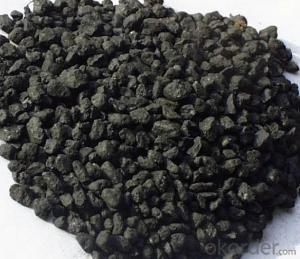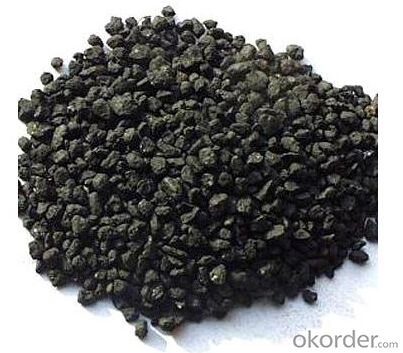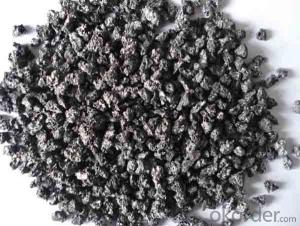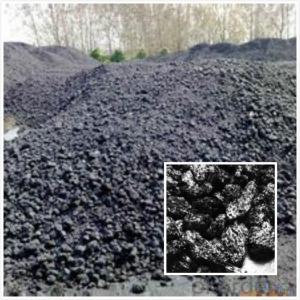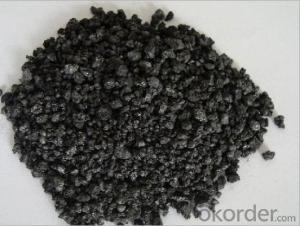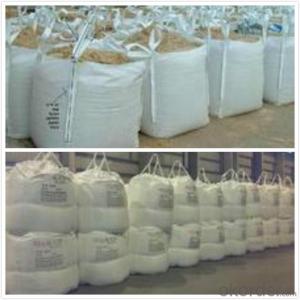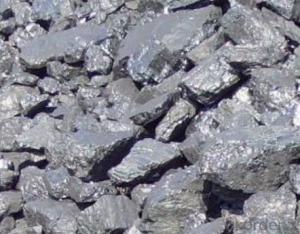Calcined Petroleum Coke Low Ash Specifications
- Loading Port:
- Tianjin
- Payment Terms:
- TT or LC
- Min Order Qty:
- 20 m.t.
- Supply Capability:
- 3000 m.t./month
OKorder Service Pledge
OKorder Financial Service
You Might Also Like
Packaging & Delivery
| Packaging Detail: | 50kg/bag 100kg/bag 1000kg/bag Or according with client need |
| Delivery Detail: | 2 weeks |
Specifications
Calcined Petroleum Coke Low Ash Specifications
Petroleum coke products can be divided into needle coke, sponge coke, projectile coke and coke breeze four kinds.
Calcined Petroleum Coke
F.C.: 98.5%MIN
ASH: 0.8% MAX
V.M.: 0.7%MAX
S:0.5%MAX
Moisture: 0.5%MAX
Structure
Calcined Petroleum Coke Low Ash Specifications
Shape: granule
Dimensions: 0-1mm, 1-5mm, 1-6mm, 2-8mm, etc
Product Type: Carbon Additive
C Content (%): 98-99.5% MIN
Working Temperature: -
S Content (%): 0.5%-0.7%MAX
Ash Content (%): 0.7%MAX
Volatile:0.8%MAX
Moisture: 0.5% MAX
ADVANTAGE: low ash & sulfur
COLOR: Black
Feature
Calcined Petroleum Coke Low Ash Specifications
Physics and chemistry performance :
Unit | Index | |||||
No.1 | No.2 | No.3 | ||||
Density | g/cm3 | 2.04 | 2.00 | 2.00 | ||
sulphur content | %≤ | 0.5 | 1.0 | 2.5 | ||
volatility | %≤ | 0.5 | 0.5 | 0.5 | ||
ash content | %≤ | 0.5 | 0.5 | 0.5 | ||
moisture | %≤ | 0.3 | 0.5 | 0.5 | ||
charcoal | %≤ | 98.5 | 98.0 | 98.0 | ||
Image
Calcined Petroleum Coke Low Ash Specifications
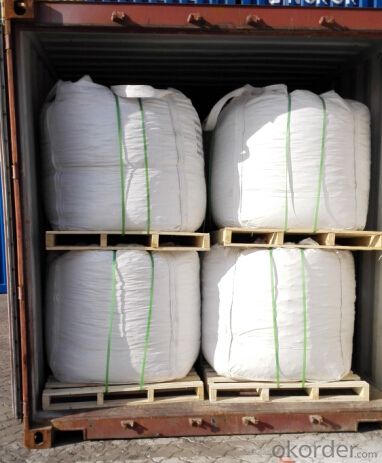
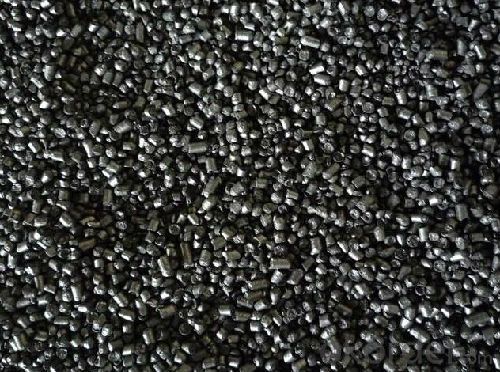
FAQ:
Calcined Petroleum Coke Low Ash Specifications
How to classify calcined petroleum coke?
1) According to difference of sulfur content, can be divided into high sulfur coke (sulfur content more than 4%), sulphur in coke sulfur content (2% 4%) and low sulfur coke (sulfur content below 2%).
2) Petroleum coke products can be divided into needle coke, sponge coke, projectile coke and coke breeze four kinds:
3) Needle coke, has obvious needle-like structure and fiber texture, mainly used for steel-making in high power and ultra-high power graphite electrode. As a result of needle coke in sulfur content, ash content, volatile matter and true density and so on have strict quality requirements, so the production process of needle coke and raw materials have special requirements.
4) The sponge coke, high chemical reactivity, low content of impurities, mainly used in the aluminum industry and carbon industry.
5) Focal or spherical coke: the projectile shape is round, diameter 0.6-30 mm, usually from the production of high sulphur, high asphaltic residual oil, can only be used as industrial fuel power generation, cement etc.
6) Coke breeze: fluidized coking process, the fine particles (0.1- 0.4 mm) in diameter, high volatile, high expansion coefficient, cannot be directly used for electrode preparation and carbon industry.
Advantage:
Calcined Petroleum Coke Low Ash Specifications
1. High quality and competitive price.
2. Timely delivery.
3. If any item you like. Please contact us.
Your sincere inquiries are typically answered within 24 hours.
- Q: I just decoration, do not understand, JS run, please feel free to show.
- LED gold tube Yuba, tinghuo... Carbon fiber was a real fire last year
- Q: Iron and steel are different in terms of carbon content
- Stainless steel is usually divided according to the structure of the organization, can be divided into austenite, ferrite, martensite and other major categories. If you go into the molten steel of different proportion of Cr Ni austenitic steel, tempered magnet is not stainless steel; if the chromium nickel steel and a small amount to in (or without nickel), tempered steel is a magnet on the stainless steel, also called ferritic stainless steel; martensitic stainless steel alloy the element is chromium, iron and carbon. Stainless steel because of the different alloy content, there are more than 100 kinds. In addition to the austenitic stainless steel magnet not on ferrite and martensitic stainless steel are magnetic. Nickel is scarce in the world and expensive. Therefore, the high nickel content of stainless steel in the market price is higher, but the magnet still can not suck. In fact, there is also a stainless steel magnet can not be sucked.
- Q: Is there any difference between carbon plate and universal board?
- Moreover, due to the characteristics of the rolling process, the mechanical properties of the steel plate vary greatly in the rolling direction and other directions (anisotropy), especially the impact power index is more obvious.In addition, the industry often encountered "cold-rolled carbon structural steel plate", "high-quality carbon structural steel plate" and so on, we should pay attention to distinguish between, do not mix.
- Q: What are the effects of carbon emissions on the stability of the atmosphere?
- Carbon emissions have significant effects on the stability of the atmosphere. The primary consequence is the intensification of the greenhouse effect, leading to global warming and climate change. Carbon dioxide (CO2), the main greenhouse gas emitted by human activities, traps heat in the atmosphere, preventing it from escaping into space. As a result, the Earth's average temperature rises, causing a range of adverse impacts. One effect of carbon emissions is the alteration of weather patterns. Increased atmospheric temperatures can result in more frequent and intense heatwaves, droughts, and wildfires. Conversely, it can also lead to heavier rainfall and more frequent and intense storms, including hurricanes and cyclones. These changes in weather patterns disrupt ecosystems, agriculture, and water availability, posing risks to human health, food security, and infrastructure. Another consequence of carbon emissions is the melting of polar ice caps and glaciers. As the atmosphere warms, ice sheets in Antarctica and Greenland melt, contributing to rising sea levels. This poses a significant threat to coastal regions, increasing the risk of inundation, erosion, and the loss of valuable ecosystems. The displacement of coastal communities and the loss of land also create social and economic challenges. Furthermore, carbon emissions contribute to ocean acidification. When CO2 is absorbed by seawater, it reacts with water molecules, forming carbonic acid. This process lowers the pH of the ocean, making it more acidic. Acidic waters harm marine life, particularly coral reefs and other organisms that rely on calcium carbonate to build their shells and skeletons. The degradation of coral reefs not only affects marine biodiversity but also impacts the livelihoods of communities dependent on fisheries and tourism. The stability of the atmosphere is also impacted by the feedback loops triggered by carbon emissions. For instance, as the Earth warms, permafrost in the Arctic regions starts to thaw, releasing large amounts of methane, another potent greenhouse gas. This release of additional greenhouse gases further amplifies global warming, creating a vicious cycle. In summary, carbon emissions have profound effects on the stability of the atmosphere. They contribute to global warming, altering weather patterns, causing the melting of ice caps, acidifying the oceans, and triggering feedback loops. Addressing carbon emissions through sustainable practices, renewable energy sources, and international cooperation is crucial to mitigate these effects and ensure a stable and habitable atmosphere for future generations.
- Q: How is carbon used in the production of fertilizers?
- Carbon is used in the production of fertilizers as it serves as an essential component in the synthesis of organic fertilizers. Carbon-based materials, such as compost, manure, and plant residues, are used to create organic fertilizers through a process called decomposition or composting. These organic fertilizers, rich in carbon, provide plants with necessary nutrients and improve soil fertility, ultimately promoting healthy plant growth and productivity.
- Q: Whether the CO2 content in the boiler smoke can not be measured, the measurement of carbon content of fly ash ah? @ @ Thank you very much!!!
- Just like oxygen measuring zirconia, the CO2 content has a specialized CO2 sensor that can be measured directly
- Q: How does carbon affect the formation of blizzards?
- Blizzards, characterized by strong winds, low temperatures, and heavy snowfall, are not directly affected by carbon. Blizzards typically occur when a low-pressure system moves into an area with enough moisture and cold air. Temperature, moisture, and wind patterns are the main factors that influence the formation of blizzards. Nevertheless, carbon emissions and their impact on the climate can indirectly affect the frequency and intensity of blizzards. Carbon dioxide (CO2) and other greenhouse gases trap heat in the atmosphere, causing global warming. This warming effect can change weather patterns, including the conditions required for blizzard formation. Carbon emissions can lead to warmer temperatures, altering precipitation patterns and increasing moisture in the atmosphere. This additional moisture, along with the necessary cold air, can contribute to heavier snowfall during blizzards. Furthermore, climate change can influence wind patterns, impacting the intensity and duration of blizzards. Changes in atmospheric circulation patterns can modify the tracks and strength of storms, potentially resulting in more or fewer blizzard events in specific regions. It is worth noting that the specific impact of carbon emissions on blizzard formation varies depending on regional and local factors. The intricate nature of weather systems and the interaction between different variables make it difficult to attribute any single weather event solely to carbon emissions. However, the overall influence of carbon emissions on the climate system increases the potential for more extreme weather events, including blizzards.
- Q: How can Dungeon Fighter Online's superior furnace rock carbon be obtained?
- Bought in cash. You can go to the mall to have a look.
- Q: The main difference between steel and iron is the difference in carbon content
- The essential difference between steel and iron is that there is a difference in carbon content.1, steel, is a carbon content, mass percentage of 0.02% to 2.04% between the ferroalloy. The chemical composition of steel can have great changes, only the carbon steel is called carbon steel (carbon steel) or ordinary steel; in actual production, steel tend to use different with different alloy elements, such as manganese, nickel, vanadium and so on;2 iron is a chemical element. Its chemical symbol is Fe. It has an atomic number of 26. It is the most common metal. It is a kind of transition metal. A metal element with a second highest crustal content.Extension of knowledge point:Iron into pig iron and wrought iron. Wrought iron, steel and cast iron is an alloy of iron and carbon with the carbon content difference. Generally less than 0.2% carbon content that wrought iron or iron, the content of 0.2-1.7% in the steel, is iron content of more than 1.7%. Soft wrought iron, good plasticity, easy deformation, strength and hardness were lower, not widely used; iron carbon, hard and brittle, almost no plastic; steel pig iron and wrought iron with two kinds of advantages, widely used for human.
Send your message to us
Calcined Petroleum Coke Low Ash Specifications
- Loading Port:
- Tianjin
- Payment Terms:
- TT or LC
- Min Order Qty:
- 20 m.t.
- Supply Capability:
- 3000 m.t./month
OKorder Service Pledge
OKorder Financial Service
Similar products
Hot products
Hot Searches
Related keywords

